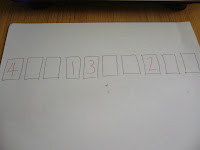1
2
3
✛
Day 6 - 28th September 2013
Multiplication and division are operations that provide interest and challenge from Kindergarten through the upper grades. Below are some games to play with the kindergarten children
Game 1: The "Buzz" game (Multiplication of 3s)
* eight players standing in a circle.
* one player starts the count from 1, the next says 2, and the third says "Buzz". Any number that multiple of 3s is "Buzz". They count up to 30, and then begin again at 1. If a child misses his or her chance to say "Buzz", that child is out from the circle. The last child standing is the winner.
Game 2: Salute.
* three players
* Items needed - A deck of cards containing only the A - 5. The Ace is 1.
* 1 player will be the dealer that give the other two players the card each. They put the card on the forehead face up. They can see the opponent's card, but not their own. The dealer announces the answer for the two cards. The first person to say the answer to his or her own card gets to keep the both cards.
Day 5 - 27th September 2013
"Selection problems are also called combination problems or Cartesian product problems. In these situations objects are mated to find all the possible ways they may be grouped." In the pictures below can you see how many ways of dressing?
Day 4 - 26th September 2013
Problem 16 - 7 birds in a row had opened my insight of multiplication. We can used at least 3 methods to find out the answer.
* doubling method
* combining distributing property
* using subtraction method.
Can you see multiplication on the 2 pictures
Day 3 - 25th September 2013
Problem 9 - At first we were given an instruction to think of how many possible ways to add 2 numbers and another 2 numbers and had the total of another 2 numbers. the rules is we cannot borrowed any other number from friend. Wow! that challenging how long am I going to complete the task. Then the expectation was narrow down to find 10 and biggest numbers of 98. Little reflection here - When we set a task for children always go from simple to complex.
I have thought of 8 ways.
Day 2 - 24th September 2013
Subitize is a new word for me and I believed to many others too. The ability to do rational counting is to subitize to count. Now I have a clearer vision of why some children do not know how to count.
* Not able to clasify
* Not able to do rote counting
* Not able to do one to one correspondence
* Do not have the conceptual understanding of cardinal numbers
When we played this is game, we have to figure out how we can get to zero. It make me reflect on the method that we are using to teach our children.
Day 1 - 23rd September 20
Ever since I was in Primary school, I did not enjoyed Math but after today lesson, I changed my thought and I think that Math is fun and we can learned Math in a very fun way. Problem 2 - The card trick was interesting. At first, we were trying to figure out by trial and error, we lay out the cards in a row and spell out and rearranged the cards and finally we got. Hurray!
The flowchart in Figure 1 shows a
comparison of major standards - the relationship of the three sets of standards
to each other. Several common characteristics across all the professional
organizations’ standards include – Developmentally effective classroom
approaches; academically prepared teachers who have the knowledge, skills, and
dispositions in curricular areas such as mathematics.
Doing math is more like doing a 1,000
piece jigsaw puzzle, where you are finished except for the blue sky. You try a
piece, then another. Perhaps you line up the remaining pieces a certain way.
You work at it and then you stop for a while. Persistence and intuition are as
important as speed. Doing mathematics –
takes time and effort. Taking more time to solve a math problem doesn’t mean
that you are less capable than someone else. In figure 2 shows that each piece of the puzzle
represents a different aspect of their vision of doing math. It involves
collaborating with others in an effort to solve problems, making and revising
representations for/of our thinking, trying to connect various ideas, and
communicating the reasoning behind our thought process to others.
Learning
is enhanced when the learner is engaged with others working on the same ideas.
Classroom need to provide structures and supports to help students make sense
of mathematics in light of what they know. And getting students to be
reflective is to engage them in interesting problems in which they use their
prior knowledge as they search for solutions and create new ideas in the
process
We as
teachers often think about what we have to do or what our students have to do
but is "doing" enough? Is it enough to have students who can simply
"do" math? I think we need to think bigger, see the bigger picture
and explore why we teach math in our schools.
 |
| Figure 1 |
 |
| Figure 2 |









